


www.farmboyzimsflightsims.com
FBZFS
Click On Any Picture For A Larger View

Thanks For The Visit !
Wings of Power
WW II Heavy Bombers and Jets
Reviewed by Farmboyzim
The folks at Shockwave Productions have put that incredible "Absolute Realism" technology into high and heavy gear with their product, Wings of Power - WW II Heavy Bombers and Jets"!
This is the second product that I have reviewed from these folks, so I was ready for that "absolute realism" this time around! The first product from the Wings of Power line that I had the great pleasure in reviewing
was their P-51 Mustang, which was
Avro Lancaster B
Focke-Wulf Ta-183 "Huckebein"
The developers of the Wings of Power aircraft suggest that you find a training manual for the specific aircraft that you want to know more about, and use it to learn to fly the Wings of Power aircraft properly. That's right! The real manual should be used for these aircraft! How much more realism do you want? The manual that is included, which in itself is very impressive, covers the basic flight parameters of each of the aircraft in the product, enough to get you up and flying without burning up the engines! It's also is rich in historical facts about these aircraft! There are abbreviated checklists, copies of official government documents concerning various aspects of the aircraft and panel information with well displayed graphics. The manual is 158 pages long but is not so technical that the beginning aviator wouldn't be able to understand it. It is well written and very interesting to read, not at all a dry technical manual, filled with statistical info that you need an engineering degree to comprehend! I was very impressed
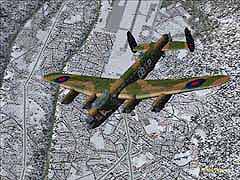
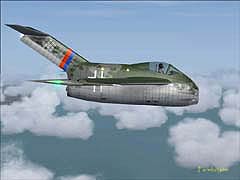
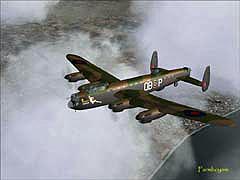
a definite eye opener! Here I thought I knew how to fly a prop job pretty good! I was humbled! The performance of the aircraft took me by surprise to say the least! I can now say that I can confidently cope with the difference in flight dynamics between the Wings of Power aircraft and your standard fare of WW II aircraft. I've learned a lot from flying these aircraft, so not only is it fun, itís an interesting technological/historical lesson about some very fine and unusual aircraft.
Let me explain here about that term "Absolute Realism", or AB, that I've been throwing around. This is a term that describes a new type of development that provides just what it says, absolute realism to your flying experience. My first taste of this realism was with their P-51. In short, I loaded the file, took a quick look-see at the manual, hopped into the aircraft, gave her the gas, and promptly lost control of the aircraft. This was the product that cured me of not looking through manuals a bit more extensively before gunning them down the runway!
AB goes beyond the point of just reproducing a few specific performance dynamics, such as top speed, max climb rate, stall speeds, etc. They go quite a few steps further and provide you with an aircraft simulation that will represent an almost unlimited amount of conditions throughout your flight. As the pilot of these aircraft, you must choose proper altitudes, manifold pressures, prop speeds, flap settings, etc, and as you make these choices, the aircraft will perform exactly as it would in real life, base on what your inputs are as pilot in command! This is a big part of the overall enjoyment of flying these aircraft. REALISM!!!
Avro Lancaster B
with the manual, as I am a big fan of products that come with a decent manual printed and ready to be referenced. They also gave it a very nice looking cover and an official look with various statements like "For Official Use Only" and such! Big points in the manual category gang! Now, onto the aircraft. Here's what you get:




Arado Ar 234 Blitz
4 Variations
Avro Lancaster
2 Variations
Boeing B17F
Flying Fortress
"Knockout Dropper"
Boeing B17G
Flying Fortress
"A Bit Of Lace"
Boeing B17G
Flying Fortress
"Shoo,Shoo,Shoo Baby"





Boeing B29
Super Fortress
"Doc's Deadly Rose"
Consolidated B24
Liberator
2 Variations
Consolidated PB4Y-2
"Privateer"
Naval Body
Heinkel He 162 A
"Volksjager"
TA 183
"Huckbein"

As you can see, there are a number of popular and unusual aircraft that are included in this product. The exterior models of each are extremely detailed, right down to the nose art depicted on some of the aircraft (big nose art fan here!). All control surfaces work in a very smooth and realistic way, including the landing gear, with its smooth operation, deploying and retracting. The detail of these working surfaces is also extremely well done. The models of the aircraft are superbly done, with authentic paint jobs depicting the liveries of the real aircraft. One would think, that with all the detail that's added with these models that the frame rate of the sim would take a beating. This is not the case with these models! I was very surprised when I turned up the clouds and a few of the other details settings and noticed only minimal performance change. I think you'll be surprised also when you run this add on and get the looks and the performance that some dream about! You know, if you're dreaming about CPU performance at night, you really have to get out more often!
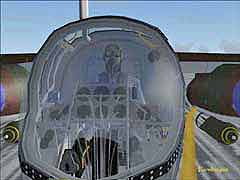
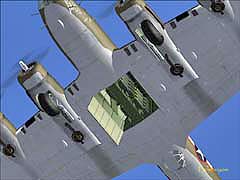
Detail is extended to areas such as the views from outside the aircraft. Note the detail of the Arado's cockpit from the external view. Wiring, back of panel, and pilot are very well done and adds immensely to the overall realistic look of the aircraft. The external working surfaces that were mentioned earlier can be seen in action with the landing gear of the Arado and the bomb bay doors on the B17. Here's a great example of that detail on the inside of the aircraft from the outside. Bombs are racked, ready and waiting, with surface details of the interior of the bay also detailed! Bombs are for looks only! Go fire up your combat sim if you get that urge! You'll see this detail in all the bombers, as well as the jets. Some of the aircraft have that shiny, new plane look, while others show the wear
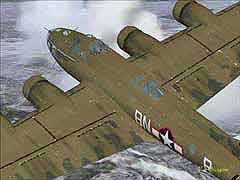
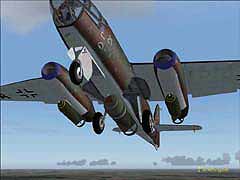
and tear that flying mission after mission can have on an aircraft. The developers have also added some very cool effects, such as smoke from engine starts, and enhanced "spark-ability" (for lack of another word at the moment!) of the effects of belly landing the aircraft in emergency situations! You can see in the pictures below, a couple of shots belly landing in the Lancaster. The Chief is going to be pretty upset about the paint job! But ya know what? Any landing you can walk away from is a good landing! Gee, have you heard that one before!?! In case you decide you know better, and try flying these beasts without the use of the information that's provided (an unwise move), there are newly enhanced effects for
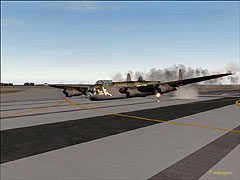
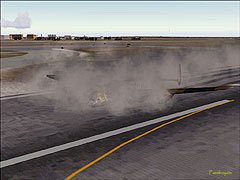
that inevitable smack with good old mother earth! After being unable to recover from a stall that ended up in my impersonation of a lawn dart, I had a first hand look at the effects! There were also some skid mark effects from the belly landing, but they faded after a bit. Very cool effect indeed! These shots really don't do the effects justice. My first situations of losing control and stalling were mostly on take off. Let
The interior of each of the aircraft are just as detailed as the exteriors. There are some objects that you may notice a polygon or two, but it certainly does not detract from the overall great looks of the aircraft! Flight decks have a very authentic look. Almost to the point that you can smell the canvas seats! Ah! The smell of new canvas! That takes me back! I found that the panels were easily read, especially with my new contacts! Each of the sub panels are also very authentic looking and very workable. The percentage of workable avionics versus "eye candy" is probably around 60/40, give or take, leaning in favor of a majority of workable knobs, switches, and buttons. I found it quite fun and educational to fly these old aircraft with the authentic panels. No FMC's will be found here! You have to eyeball those gauges constantly! Here you thought it would be a boring flight over the Atlantic with nothing to do! The virtual cockpit views are just as clear and readable as the 2D views, and quite enjoyable to fly from, as everything that's workable in the 2D is, for the most part, workable in the VC.






























why these avionics were used, but I am certainly not complaining! It gave me more time to focus on manifold pressures, prop rpm's, and climb rates! Functions of the C-1 Auto Pilot are covered within the manual, with all functions nicely labeled.
Here's an abundance of shots of the various aircraft's cockpits, VC's, and sub panels:
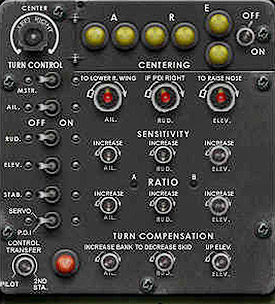
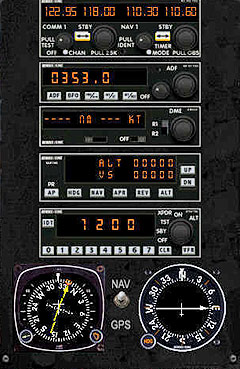
Autopilot systems were most authentic in the B17, Lancaster, and the B29, which utilize the C-1 Automatic Flight Control System. These are not complicated avionics to figure out, as everything is fairly to the point. The other aircraft sport a more modern avionics stack, which was fine by me! There's plenty of authenticity already spread about. May as well spring for an updated avionics package for a couple of the aircraft! The auto-pilot in these updated versions works the same as the default avionics in MSFS2004. I'm not sure
Let's cover the aircraft in this package in a bit more detail:








The Avro Lancaster B Mk.III / Mk. I "Special" was Britain's primary punch for their nighttime bombing missions. Utilized as a low-level bomber, it carried up to 14,000 pounds of ordnance. Famous for its roll in the "Dam Buster's" missions, it carried special cylindrical bombs used to destroy dams. A stripped down version was able to carry a single "Grand Slam" bomb, weighing in at 22,000 pounds. Not as heavily armed as the B17 and carrying less defensive armament and equipment, crewed by seven, and not having to climb to the higher altitudes were the reasons they were able to carry more of a bomb load. Powered by the magical Merlin engines, by Rolls Royce, it was able to get off the
ground, using less runway. Performance fell off above 20,000 feet for lack of a turbo-supercharger. The aircraft handles well, and fly's itself right off the runway. Pilot Comment: "She's a steady, stable airplane that'll get you home if you treat her right." Hmmm...Sound familiar?
Those of us that are familiar with the roles that many types of aircraft have played in the war's over time know that they all have their own excellent (in most cases) attributes. But if you were to ask most people, enthusiasts of aviation or not, to name a bomber from WW II, most would probably say the B17 Flying Fortress, by Boeing. The aircraft went through various modifications that led to the B17G. With a range of 2000 miles, a speed of 287 mph, service ceiling of 35,800 feet (Brrrr!), 13 machine guns and four turbo charged 1200 hp engines; it's obvious why it was nicknamed the "Flying Fortress"! The B17 was a veteran of just about all of the US air campaigns, including those over North Africa and
the Middle East. Because of their role of daytime bombing, the B17 took severe losses from the Luftwaffe until air support was able to accompany them to the target and back home. Pilot Comment: The B17 was designed for 200-hour pilots who came straight from the farm (hey, what does he mean by that!) and into flight training. It was meant to be as easy to fly as a four - engine bomber could possible be. It's rugged, simple, and has a good temperament. It takes a lot to piss it off."
The only jet powered bomber to make it into action during WW II was the Arado Ar-234. As with many aircraft, it's role started out as one thing and developed into another, In the case of the Ar-234, it's initial role was that of a recon aircraft, but was later adapted for recon / bomber missions. It carried a 1,500 Kg compliment of bombs externally, and gave allied pilots fits of frustration trying to catch it, as it sped away using its turbo-jet engines. Nicknamed the Blitz (Lightening), it was sleek, fast, and handled as well as it looked. Future plans held the development of a variation that would have utilized four BMW engines, but the war ended before these designs came to be. Quite a bit of technical
C-1 Automatic Flight Control System
knowledge was gleaned from the captured aircraft after the war. Pilots Comment: "The Blitz was a wonderful aircraft to fly, with excellent handling and well harmonized controls". It did however, need quite a bit of runway for take off and landing, and was equipped with a para-brake.
The Consolidated B24 "Liberator" Model 32 was a very advanced aircraft for its time. The systems utilized in this aircraft were so advanced that the crew's required special, extensive training in their functions and teamwork was more important than ever. The feature that stood out most on this aircraft was the difference in the style of wing configuration, utilizing a high-aspect ratio Davis wing. The aircraft proved difficult to fly, marginally stable, and was usually flown with maxed out weights, which didn't help matters any. Trim control was essential or you'd find yourself meandering all about the wild blue! An unforgiving aircraft, it demanded a lot from its crew. It did its job effectively though,
thanks to the skills of the brave crews that flew them. 18,188 B24's were made, compared to 12,731 B17's and 7,366 Lancasterís. At the time that the manual was written, only one B24J remains flying cared for by the Collings Foundation out of Stowe, Massachusetts. It continues to tour the US and the team from Wings of Power had a chance to actually fly in this aircraft on two occasions, walking away with a deep respect for the crews that flew her. Pilots Comment: "You could always tell a Liberator pilot by the bulging biceps muscles in his left arm, from hauling on that yoke for 14 hours at a stretch".
The PB4Y-2, "Privateer" was the naval version of the B24, with had many different modifications from its army cousin. The first distinctive feature was the single, massive tail instead of the twin that was sported by the B24. It was also heavily armed, having multiple powered turrets and two waist-gunner positions. The most distinguishing difference though was its engines, not being turbo charged; it relied on its superchargers to gain altitude, which was a max of 12,000 feet. This was perfect for the task of maritime patrol however, along with low level shipping strikes. The endurance of the Privateer was incredible by the standards of the time. Missions of up to 18 hours were not uncommon, with a
range of up to 3,000 miles. Pilot Comments were the same for the PB4Y-2 Privateer as they were for the B24 Liberator.
The designs of the MiG-15 of the Korean war era were influenced by the Focke - Wulf Ta-183 "Huckebein", which was a very simple, single engine (within the fuselage), delta winged fighter, that only lived on paper, as it never was built. The Ta-183 is very fast, with speeds up to 600 mph, and highly maneuverable. It had a short combat radius of only 350 Km that would have been a handicap to its combat performance. The danger of "over-controlling" the aircraft at slower speeds exists, so care must be taken in landing and take off situations. This is another aircraft that needs a lot of runway to take off and land. Pilot Comment: "The Ta-183 would likely have handled very much like a Korean war
vintage jet fighter. With a projected top speed of nearly 600 mph at altitude, and a climb rate of nearly 6,000 feet per minute, the Ta-183 would have easily disposed of any piston engine fighter with its four cannons". That's an understatement!
The Boeing B29 "Super Fortress" was a long range, high altitude bomber that had quite a troubling start in its early days. The engines were prone to over heating and fires were common with disastrous results. It's like one of those fancy, well equipped cars of today, with all kinds of extras that unfortunately break down on a regular basis. The more complex, the more opportunity for problems, and this held true with the Super Fortress. Even so, the B29 was an incredible development in aircraft technology for its time, having a pressurized crew compartment, remote controlled gun positions, and it could carry a whopping 20,000 pounds of ordnance to the enemy and hopefully return home. Another
aircraft that usually took of at maximum loads, the B29 never really inspired the confidence that the B17 did with the crews. A failed engine at take off in the B 29 usually meant an emergency situation resulting in a crash. Thousands of Super Forts made the trip to the enemy and back however, and would have seen action in the European theater had the war gone on longer there. Pilot Comment: "The B29 responded quickly and accurately to the controls for such a large airplane. It was like the B17, it was a good aircraft to fly, but you had to watch those engines and keep them cool. That was something we didn't have to worry about on the B17. But we flew them anyway, and most of us made it back. We were just doing a job."
Here's an oddly cool looking aircraft, the He 162A "Salamander" (where did they get these names!). The Salamander was an effort made by the Germans in the latter part of the war to create what they called the "People's Fighter" (Volksjager). The aircraft was developed in an incredible short time of 69 days when its first test flight was conducted. A simple design that could be made by unskilled labor, it also used fewer strategic materials than most aircraft. Stuff was running short! The result was the Salamander that was actually quite fast, agile and lethal. The He 162A was plagued by the same shortcoming as the Ta-183 however, and that was a short combat radius. Because of the limited fuel
supply, the only option the Salamander had if enemy fighters showed up was to run. But again, the plane never saw combat, for the war had ended, and of course, production ceased. Pilot Comment: This plane is fast and agile with a good rate of climb. It has the quickest rate of roll and the lightest control touch of any aircraft of this type above 400 mph. It stalls predictably, but it requires an experienced, practiced touch on the controls, which are very responsive. It's easy to over-control this aircraft, and can be quite a challenge to take off and land. Treat it with respect."
This product has the distinction of being "The Highest Rated Microsoft Flight Simulator 2004 add-on ever created"
(BASED ON ALL INDEPENDENT REVIEWS IN GAMERANKINGS DATABASE AS OF APRIL 2005) and I can surely see why! You should have at least a few hours under your belt with flying larger aircraft, and be familiar with the basic avionics of aircraft. This is a product though, that would be great learning tool, since the "Absolute Realism" that Wings of Power promises you will give you a new look at what you thought was proper flying techniques.
Well, I hope I didn't overload you on information like they did with the bomb loads on some of these aircraft! I just couldn't help but enjoy writing this review immensely, for historical aircraft, simming, and writing are some of my favorite hobbies. Besides that, this product gave me a lot to write about! About the only thing I could wish for was the ability to move to the various positions throughout the aircraft. But you're in these birds to fly them, not ride along as a passenger! The above information was referenced from the manual that comes with the product, and this is only a small taste of the invaluable information that it contains. The cost of the product is an unbelievable $28.99 plus $7.50 for shipping and handling to North America for the boxed CD-Rom version. I truly think this is one of the sweetest deals around! Extremely accurate renderings of aircraft with beautiful liveries, and a goodly number of them, I might add, frame rate friendliness in various resolutions...What more could you want? Especially if you're into these war birds like I am!
the plane do the work and fly itself off the runway. It will do it, smooth as silk! Try not to over control.

System Requirements:
MSFS2004
Pentium II 500 MHz or faster or an equivalent processor
At least 500 Mb of hard disc space
CD Rom Drive
Recommended to have a sound card
3D Graphics card
Windows 9x/2000 or better
DirectX 9 or higher
Installation of Wings of Power WW II Bombers and Jets was from a single CD, and was very simple and hassle free. It also did not take very long at all to install. After installation, the addition of a Wings of Power logo in the lower right corner of your start up splash screen appears, but it looks pretty good, so I left it!

































































